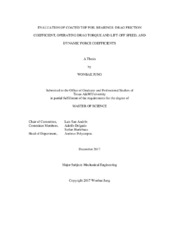| dc.description.abstract | Despite their many advantages, bump-type foil bearings (BFBs) have issues of dryfriction during sliding contact at rotor start/stop cycles. To prevent premature wear of both shaft and the BFB, the proper selection and application of a coating on the top foil is of importance to ensure bearing long life. This thesis presents measurements characterizing the static and dynamic load performance of a Generation I BFB having uncoated and coated (VN, TiSiN, MoS₂) top foils. The bearing, with length L and diameter D=38 mm, integrates a 360° 0.127 mm thick top foil made of Inconel X-750, and a 27 bumps strip layer, 0.47 mm in height, made of the same stock as for the top foils. The VN and TiSiN coating, 0.005 mm thick, applies to the front and back surfaces of a top foil. The MoS₂ coating, 0.020 mm thick, is sacrificial. The tests were conducted at room temperature (21°C).
The dry-sliding torque (T), recorded with a precision meter, increases linearly with an increase in applied static load (max W/(LD)=25.6 kPa). The bearing with a VN coated top foil shows the largest turning torque. The dry-sliding friction factor f =T/(1/2 WD) decreases as the specific load (W/(LD)) increases. As expected, journal rotation towards the top foil free end (clockwise) produces a larger f than for rotations in reverse.
A test-rig records the BFB drag torque during rotor acceleration and deceleration procedures to/from 70 krpm (138 m/s). The vertical load applied into a bearing equals W/(LD)= -8.0 kPa, 0 kPa and 8.0 kPa. In general, the bearing with a coated top foil shows a lesser drag torque than that of the uncoated top foil bearing. Among the coated foil bearings, the bearing with VN coating shows the highest drag torque, whereas the one with MoS2 shows the lowest. The drag torque increases with an increase in applied static load. Generally, the drag torque while the rotor is airborne is small (less than ~10% of peak torque). When the rotor starts up, the dry-sliding friction coefficient (f) of the bearing with VN coating is ~0.4 while f for the bearing with TiSiN coating is 0.3~0.4. The uncoated bearing shows the largest f ~0.6, and the MoS₂ coated one has the lowest f = 0.2~0.3.
Dynamic load tests spanning excitation frequencies (ω) from 200 Hz to 400 Hz serve to identify force coefficients for the test BFBs with a specific load of 16 kPa and operating with shaft speed at 50 krpm (833 Hz). Baseline measurements correspond to a null applied load and no shaft rotation. The test bearings show a remarkable behavior with nearly isotropic direct coefficients and very small cross-coupled ones. The bearing direct stiffnesses (K) increases with frequency, whereas the direct damping coefficients (C) quickly decrease. The bearing material loss factor, γ=ωC/K, represents best the BFB ability to dissipate mechanical energy. Over the excitation frequency range, γ= 0.34, 0.28, and 0.12 for the uncoated, VN coated and TiSiN coated bearing. The test data show the bearing loss factor does have a correlation with the dry friction coefficient as γ ~ 0.71 f at a rotational speed of 50 krpm. Since the top foils with VN or TiSiN are coated on both sides, kinetic friction between the back of a top foil and the bumps’ crests likely lessens during sustained contact. | en |


